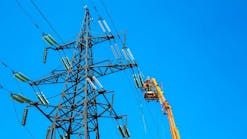There are a number of people in the market who suggest that electric transmission has outlived its usefulness and that, as a country, we should no longer be investing in or supporting investments in electric transmission. While that may be a goal for many, I believe that it is a goal that is neither practical nor realistic in the foreseeable future. There are a host of reason why we will continue to be dependent on transmission, not least of which is the role that transmission has played and will continue to play in increasing the percentage of renewable energy in the mix and its significant role in helping to significantly lower the costs of renewables.
Looking at the question of the need for, and longevity of, electric transmission, we can focus on four of the significant reasons why transmission will continue to be an integral part of the energy infrastructure, even with the proliferation of microgrids.
Energy Density
The energy density in most urban and semi-urban areas is beyond the delivery capability of distributed renewable technologies, even with storage. To eliminate transmission supplies to urban and semi-urban areas, we would have to deploy a combination of renewables, heavily augmented by distributed generation using conventional fuel sources. In the best case, where these conventional units are fueled by natural gas (or methane from sewage treatment facilities) there would be a need to significant increases in the fuel delivery infrastructure. Many of the urban areas in the country are already under restrictions on the amount of new emissions that can be allowed.
Hence, the addition of localized generation would be problematic and unlikely to be approved on a scale sufficient to eliminate the need for transmission. Moreover, the conventionally fueled local generation would supplant renewable generation (primarily wind) as well as more efficient or other non-emitting sources. Thus, we could be trading a desire to eliminate transmission for a degradation in air quality at a local level and an increase in GHG at a national level.
It is easy to see the complications for urban areas. In truth, the same situation exists for residential, commercial and manufacturing. In a large number of cases, roof top solar cannot meet all the needs of the home, even with storage. Whether driven by orientation of the home, design of the roof, or the fact that it is a multi-family dwelling, a great many of the homes with solar, do not have the capacity to generate 100% of the needs of the home during the available sunlight hours. It is logical that we would add community solar, using available public space, pole mounted units, and a combination of community based and personal energy storage. While adding all of these technologies to existing communities would no doubt reduce the level of loading on the transmission system during the day, it is unlikely that it would be able to meet the entire need of the community. If we add commercial and manufacturing into the equation, we are back to the energy density dilemma and are once again reliant on either transmission or localized generation using conventional fuels.
Policy Decisions and Promises
Most states have made commitments to increase the level of renewables in the power supply mix. Some are extremely ambitious while others more cautious. Given the state of current renewable technologies, the only way most states will be able to meet their policy goals, or stated commitments, within the timeframes is through a combination of grid-scale renewables, customer-based renewables and greater energy efficiency. The majority of grid-scale renewables require transmission to deliver the energy. Without the transmission (existing and planned), most of the states would be unable to come anywhere close to their goals.
Moreover, the renewables community has made significant financial investments in the grid-scale plants, based in large part on the basis of the policy and supporting regulation. A reduction in transmission capacity would undermine the financial viability of these investments. These investments have enabled the states to achieve their progress/success to date on their renewables goals. It is unlikely that policy makers and regulators would promote or support policies that would undermine these investments during the initial contract periods proscribed by the regulators.
Security of Supply Requires Diversity of Supply
Looking at the history of the electricity industry, we started out as a collection of disparate micro-grids. As the demand for electricity grew, so too grew the need for reliability of supply. The industry responded by interconnecting the micro grids. The increased reliability resulted in increased reliance, and thus greater interconnection. The greater interconnection led to economies of scale in energy production, lowering the cost, which of course increased the viability of electricity as a driver of productivity.
We are now heavily reliant on cost-effective and reliable electricity to sustain our economy. The link between the two is undeniable. One only has to look to second and third world countries as well as newly emerging nations to see the role that cost-effective, reliable electricity has played in their growth.
As an industry and as a nation, we have come to recognize the need for diversity of supply. National and state regulation relating to reliability have been developed factoring in diversity of supply. Our calculations on reserve margins and contingency planning are deliberate in considering the diversity of supply and recognizing vulnerabilities that come from being too dependent on any single generator or any single transmission corridor. This thinking has enabled the industry to be able to deliver its product at levels of reliability of 99.9%.
It is logical to expect that customers, regulators and policy makers will expect the same levels of reliability and security of supply, even as we move to greater reliance on microgrids and integrated distributed resources. Given the issues with energy densities, electric transmission will continue to be an essential asset in ensuring the levels of reliability that have become an integral part of our economic success.
Market Forces Drive the Costs of Renewables and Transmission Provides Access to the Markets
Over the last decade, the penetration of renewables has increased dramatically. There are several factors that account for the increase uptake in renewables. Clearly policy and regulation were major drivers. It is also true that transmission played a significant role in enabling this growth. Not only did it provide the connection to remote sites where the cost of renewables was attractive, it provided access to the markets where the value of the renewables could be fully leveraged. The combination of policies and regulation that favored renewables would not have been fully successful without access to the markets. The growth in renewables and the ability to trade in the market increased the competition in the renewables sector helping to spur efficiency (both capital cost and energy production per unit foot print). The result has been a steady decrease in the cost of renewables in real terms over this time period.
The effect of the market cannot be understated. CAISO and others in California are calling for standards for rooftop solar that would enable more effective aggregation of distributed solar, such that the aggregated resource can be bid into the market. The expectation is that this would drive greater penetration and greater efficiency into this resource pool.
If we assume that transmission will be removed from the equation, then we must assume that we will be removing market forces from the equation. There are those that would argue that the distribution system could serve as the market infrastructure for distributed resources. While this is true it would be limiting new technologies to neighborhood markets with similar load and supply patterns and would preclude them from being fully leveraged in regional markets where the diversity of load and demand are so much more pronounced.
Such an arrangement would not only stifle the economic drivers but would likely result in a much greater installed base of generation than is needed. Leveraging the transmission system to enable regional load balancing allows us to be more efficient in the amount of generation deployed and ensures greater access to the most efficient sources of energy.
Doing away with transmission would undermine the goals and objectives of the major proponents of renewable energy.
In short, electric transmission has been and should continue to be a major enabler of the growth of our economy. It has seen us through our industrial growth and can provide the same value to the growth of our low carbon, renewable energy economy.


